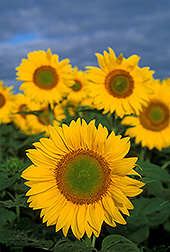This page has been archived and is being provided for reference purposes only. The page is no longer being updated, and therefore, links on the page may be invalid.
|
|
New Sunflower Lines Resist Fungal Disease
By Jan SuszkiwAugust 3, 2007
Three new germplasm lines are now available for breeding elite sunflower hybrids that will resist downy mildew and produce oil rich in oleic fatty acid.
Agricultural Research Service (ARS) and North Dakota Agricultural Experiment Station (NDAES) scientists in Fargo jointly developed, tested and released the new sunflower lines, dubbed HA 458, HA 459 and HA 460. Besides resistance to the fungus Plasmopara halstedii, which causes downy mildew, the sunflower lines are being released for their high levels of oleic fatty acid, which imparts desirable flavor, frying characteristics and other traits to oil.
The downy mildew fungus attacks sunflowers as both seedlings and mature plants, causing white cottony growths in the young plants, and large, clublike roots and stunted growth in the older ones.
Until recently, sunflower growers kept mildew in check by planting seed treated with metalaxyl, but the fungus has become resistant to this fungicide. Seed company breeders scrambled to develop downy-mildew-resistant hybrids, making these new germplasm releases invaluable. The emergence of virulent new downy mildew races—from two before 2003 to 15 currently—has spurred the need for hybrids with new sources of disease resistance, notes Tom Gulya. He's a plant pathologist in the ARS Sunflower Research Unit (SRU) at Fargo.
Gulya assisted SRU geneticist Jerry Miller, now retired, in developing HA 458, HA 459 and HA 460 by crossing elite sunflower lines with wild sunflowers collected from Idaho and Texas by SRU botanist Gerald Seiler over the past 20 years. Jack Rasmussen of NDAES collaborated with them.
In repeated field and greenhouse tests at Fargo, all three lines resisted the most virulent races of downy mildew fungus found in North America. HA 458 and HA 460 also withstood a French race not yet found in America. Oil extracted from HA 458 and HA 459 averaged 86.5 percent and 87.3 percent oleic acid, respectively. Oil from HA 460 had 88.8 percent oleic acid.
SRU research leader Brady Vick is filling seed requests.
ARS is the U.S. Department of Agriculture's chief scientific research agency.

